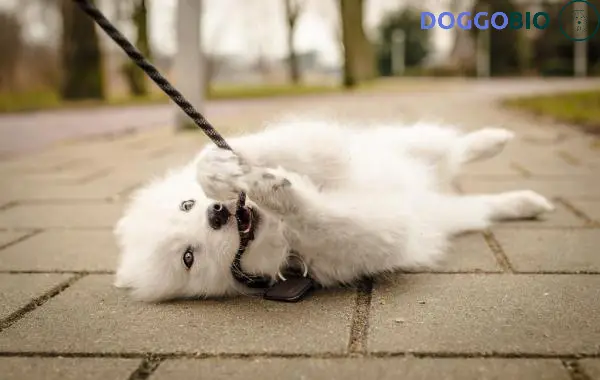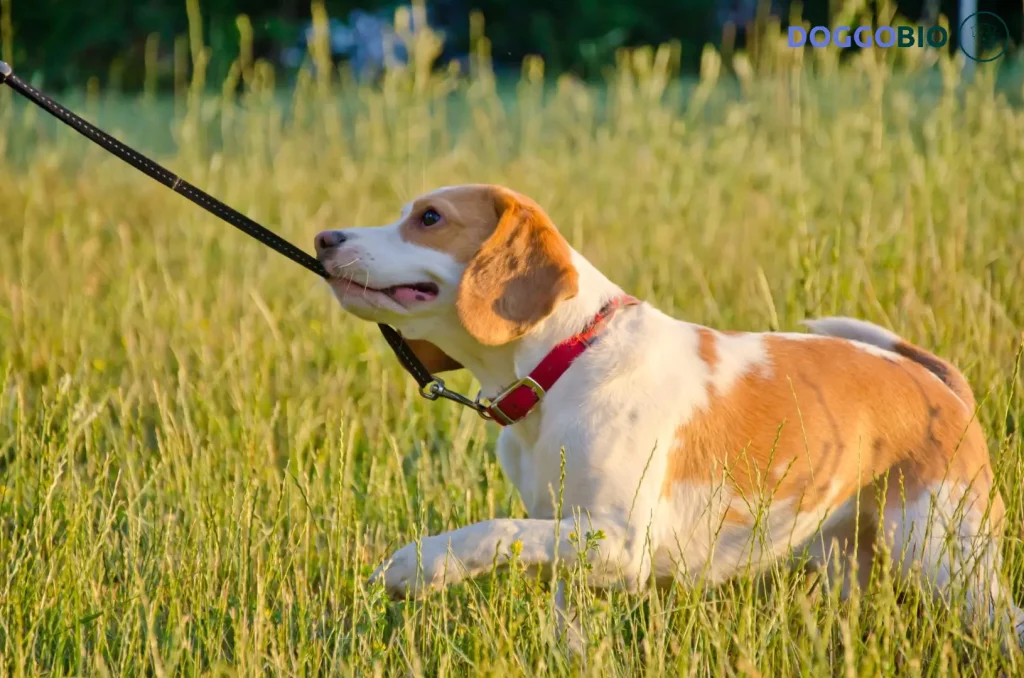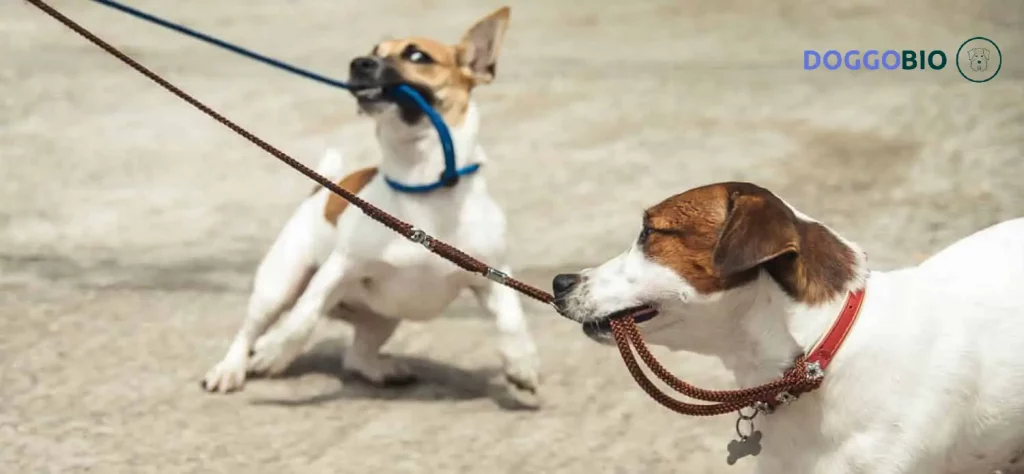Dogs can sometimes exhibit unusual and challenging behaviors when they are out for walks, including biting or chewing on their leash. This behavior can be frustrating and concerning for pet owners, and it can even cause the leash to break or the dog to escape. If your dog has developed the habit of biting their leash while walking, it is essential to address the issue promptly to avoid any potential problems.
In this guide, we’ll explore “How To Stop Dog From Biting Leash” and delve into various strategies to address this behavior, including training for dogs. We will cover topics such as identifying the underlying cause of the behavior, using positive reinforcement training, and selecting the right equipment to discourage biting.
By understanding the reasons behind this behavior and following the tips and strategies outlined in this guide, you can help your furry friend learn to walk calmly and obediently without chewing on their leash.
Why Do Dogs Bite The Leash?
As a canine enthusiast, you may have noticed that dogs have an inexplicable propensity for biting on their leashes, leaving many pet owners perplexed and wondering why.
While the answer to this question may seem straightforward, the intricacies of this behavior are anything but. Let us delve deeper into this enigmatic phenomenon to unravel its underlying complexities.

1.Frustration
There are many reasons why dogs might choose to sink their teeth into their leash while out on a walk. One of the most common explanations is that they’re simply trying to eliminate the darn thing.
After all, it’s only natural for dogs to want to run free and explore their surroundings. The leash, unfortunately, can feel like a constraint to them. And when they feel like they’re being held back, they might try to take matters into their paws and bite the leash to break free.
But don’t worry. This behavior doesn’t necessarily mean that your dog is angry or aggressive. It’s often just a sign of frustration. It can still be frustrating for you as an owner, especially if you’re hoping for a peaceful walk with your furry friend.
2.Anxiety
One of the most common reasons dogs may engage in leash-biting is anxiety, which can be triggered by a myriad of factors such as unfamiliar surroundings, the presence of other dogs, or a lack of familiarity with walking on a leash. Identifying the root cause of their anxiety can be challenging, as dogs cannot verbalize their emotions.
Nonetheless, pet owners can mitigate this behavior by implementing counter-conditioning techniques, gradually exposing their furry friends to the stimuli that cause anxiety while rewarding them for exhibiting calm behavior.
3.Excitement
As highly dynamic creatures, dogs are susceptible to various emotions, including excitement. This excitement can be triggered by multiple stimuli, such as the presence of other dogs or humans or even the anticipation of going for a walk.
This excitement can sometimes manifest as leash-biting, as the dog’s excitement spills over into their behavior.
To curb this behavior, training your furry friend to exhibit self-control when exposed to exciting stimuli is essential. This can be achieved through counter-conditioning techniques, such as gradually exposing your dog to the stimuli that trigger excitement while rewarding them for calm behavior. It is also crucial to provide ample opportunities for exercise and playtime to help your dog release pent-up energy.
However, as with all canine behavior, there are no one-size-fits-all solutions. Each dog is unique, and their triggers for excitement may differ. As a pet owner, observing your furry friend’s behavior and identifying their motivations for excitement is crucial. This can help you tailor your training methods to address their needs effectively.
4.Attention-seeking
Dogs are social creatures and crave attention from their human companions. This can manifest as leash-biting, as dogs may view this behavior as a way to grab their owner’s attention and initiate play or go for a walk.
But how can pet owners differentiate attention-seeking leash-biting from other causes? The key lies in observation. If a dog is persistently biting their leash, despite having adequate exercise and being free from anxiety triggers, it may be a sign that they are seeking attention. In such cases, pet owners can redirect their dog’s attention by providing toys or treats or engaging in interactive play.
It is also essential to note that ignoring attention-seeking behavior can reinforce it, as dogs may resort to more extreme measures to grab their owner’s attention. Providing positive reinforcement for desirable behavior, such as playing or going for a walk, is crucial to discouraging leash-biting as attention-seeking behavior.
5.Boredom
Dogs are active creatures; if they are not provided with enough exercise or stimulation, they may bite their leash to alleviate their boredom. This can be a challenging behavior to address, as it requires identifying the root cause of the boredom and managing it accordingly.
If a dog is biting their leash due to boredom, providing more exercise and mental stimulation, such as puzzle toys or interactive play, may be necessary.
Chewing toys can also help address leash-biting due to boredom, as they provide an outlet for a dog’s natural chewing behavior and can prevent them from gnawing on their leash, which can lead to dental problems.
How To Stop Dog From Biting Leash?

1.Remember Him The Leash, not a Toy.
Dogs can get pretty riled up when they think they’re about to go for a walk. If your pup is one of them, then it’s likely that he’ll start jumping around and trying to play with the leash as soon as he sees it.
But don’t give in! If you engage with the leash like it’s a toy, you’ll only make things worse.
Remember, your dog doesn’t understand that the leash isn’t a toy. He sees it as another fun thing to play with!
So, when it’s time to go for a walk, take a deep breath and try to remain calm. If your dog starts biting at the leash, don’t play along. Instead, ignore that behavior and wait until he’s calmed down before you begin the walk.
Your dog will learn that leash time is serious business and that there’s no room for playing around.
2.Don’t Pull Back
When your furry friend starts gnawing on his leash during walks, pulling it back to get it out of his mouth is natural. However, this isn’t the solution you’re looking for! Believe it or not, pulling the leash back may worsen the situation.
You’re giving your dog more attention, and your dog doesn’t know the difference between good and bad attention. To break this habit, you must use positive reinforcement dog training.
3.Teach your dog to focus on you.
To start, try to keep your dog’s attention on you as much as possible by calling his name and rewarding him when he looks back at you. And remember to reward him every time he chooses to focus on you instead of something else, even if you didn’t ask for it!
By teaching your dog to focus on you, you can prevent him from getting too excited and biting his leash. So, try it next time you walk and see how it goes!
4.Use positive reinforcement.
It’s essential to reward your dog for good behavior when leash training. This can be challenging, as it requires patience and consistency. However, it’s crucial to persevere and not give up.
When you put your dog on a leash, have plenty of high-value treats. Whenever your dog exhibits good behavior, such as staying close to you or looking in your direction, reward them with a treat and praise.
It’s also important to encourage your dog to engage appropriately with its environment by stopping to sniff. This is a natural and calming behavior for dogs, and it can help prevent leash biting. By frequently rewarding positive on-leash behavior, you can teach your dog loose-leash walking and discourage biting.
Remember, reinforced behavior is more likely to be repeated, so rewarding your dog for good behavior is essential.
5.Correct behavior immediately.
To stop your dog from biting his leash, you must be proactive and immediately correct the behavior. Whenever you see your dog starting to bite his leash, say “no” firmly and redirect his attention to a toy or treat.
Consistency is critical, so correct the behavior every time it happens. Don’t tolerate nibbles or playful bites; they can quickly escalate into a full-blown leash-biting habit.
6.Give Him a Toy
Some dogs naturally tend to be mouthy, which can lead to them biting their leash. But don’t worry, there are ways to redirect their behavior.
One option is to provide your dog with an alternative behavior, such as holding a ball or a toy while walking. For dogs that love to tug, carrying a toy can be a great way to discourage leash biting.
Use the tug toy before your dog starts biting the leash to make this work. This way, you can reward your dog for walking without biting the leash and give them something else to focus on.
Tug toys are a great way to channel your dog’s energy and provide a positive outlet for their desire to chew and play. So, try it and see if it works for your pup!
7.Leash Handing
You must be mindful of your leash-handling skills when walking your furry friend. Keeping the leash loose and behind your dog can help reduce conflict between you and your dog on a walk.
Dogs can get frustrated and start spinning around to tug at the leash when it gets tight. Additionally, if the leash dangles in front of their face, dogs might think it’s a toy and start biting it.
We know that leashes aren’t toys, but dogs don’t have that knowledge ingrained in them. So it’s up to us not to dangle the leash in front of them like a toy.
Also, remember to reward your dog frequently for loose leash walking, checking in with you, and appropriate engagement with the environment. Doing this makes your dog much less likely to get frustrated and start biting the leash.
8.Create a positive experience while walking.
Creating a positive walking experience for your dog is crucial if you want to stop him from biting his leash. To do this, you must ensure you are not pulling on his leash or yelling at him, as this will only make him more anxious and stressed.
Instead, use positive reinforcement by giving him praise and treats when walking nicely without biting his leash. Also, try to make the walk enjoyable for your dog by letting him sniff and explore his surroundings.
9.Keep your dog positive.
Please keep your dog from being bored while walking by engaging him in games or training. This is important to keep your dog from biting his leash.
You can teach him to walk beside you, play tug-of-war, or even teach him some basic commands like sit or stay. These activities will not only help him to focus on something other than his leash but will also help to reinforce positive behavior.
10.Exercises
To prevent a dog from biting the leash, exercise is essential. Keeping your dog active at home and on walks can help them resist the urge to pull on the leash.
Giving your dog the freedom to run in the backyard is fantastic. With enough exercise and release, your dog will have the energy to resist biting the leash and enjoy the walk without any tension.
What Should You Not Do When Your Dogs Bite The Leash?

1.Punishment
When your furry friend is nibbling on his leash, knowing what actions are counterproductive is essential. One of the most crucial things to avoid is punishing your pup for this behavior. Dogs often resort to leash-biting to cope with emotions, and punishment only exacerbates the problem.
Punishment can make a dog anxious and stressed, leading to further leash-biting or other undesirable behaviors. Instead of punishing your dog, it’s essential to focus on training techniques that can address the underlying cause of the behavior.
Positive reinforcement is an effective way to train dogs and can help reduce leash-biting. Rewarding good behavior can reinforce the desired behavior and discourage the unwanted one.
It’s also important to avoid using aversive training techniques, such as shock collars or choke chains, as they can cause physical harm and increase anxiety in dogs.
2.Yelling
One of the crucial things to avoid is yelling at your dog. When you shout, it can frighten your furry friend, making him more anxious and stressed.
Instead of yelling, it’s essential to understand the root cause of your dog’s behavior and address it appropriately. Dogs may bite their leash out of boredom, anxiety, excitement, or the desire to play. Punishing them for the behavior is ineffective and can worsen the situation.
Moreover, dogs are incredibly perceptive to our emotions, and yelling may communicate fear, anger, or stress. This can strain the relationship between you and your dog, making them more likely to engage in destructive behavior.
3.Hitting
It is important to remember that hitting your dog should never be used as a form of punishment, especially regarding leash biting. This method of discipline can cause your furry friend to become more anxious and stressed out, making the situation even worse.
4.Pull on the leash
When trying to stop your dog from biting his leash, it is crucial to avoid tugging it. This is because pulling the leash can exacerbate the situation, leading to injuries and a heightened sense of playfulness in your pup. Furthermore, your dog may not release the leash if he thinks you are playing along with him.
Frequently Ask Question

1.How to guide a dog to walk on a leash?
Golly gee, getting a stubborn dog to walk on a leash can be challenging! Don’t fret, though. There are various things you can try.
Firstly, teaching your pup basic obedience commands like sit and stay can help establish control. Consider using a harness or headcollar to prevent your dog from pulling on the leash.
It’s all about finding what works best for your particular puppy!
2.Why is leash training so hard?
Leash training can be perplexing because it demands a high degree of perseverance and uniformity. It is crucial not to throw in the towel on leash training, even if it appears to be a daunting task initially.
With enough time and dedication, most dogs can learn to walk calmly on a leash. Nonetheless, every dog is unique and may require different approaches to succeed.
Conclusion
In conclusion, if your dog has developed the habit of biting their leash while walking, it is essential to address the issue promptly to avoid any potential problems.
Understanding the reasons behind this behavior and following the tips and strategies outlined in this guide can help you train your furry friend to walk calmly and obediently without chewing on their leash.
Remember to identify the underlying cause of the behavior, use positive reinforcement training, and select the right equipment to discourage biting.
With patience, consistency, and the right approach, you can help your dog overcome this behavior and enjoy stress-free walks together.
